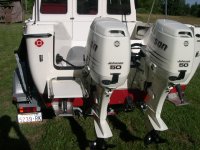Before the last 20 years & 25,000 miles of cruising in our CD22 with twin motors, of which, many of those miles were in areas, where a vhf radio was not going to obtain help if needed, we explored some very remote areas in Alaska, British Columbia & the Yukon & Northwest Territories, alone with a single motor on a 12.5 foot inflatable boat. We never had a problem of any kind with that motor & the only back up was a set of oars & so yes, even 20+ years ago, outboards had become very dependable, but not entirely so, as myself & many others have experienced. When JoLee & I were out cruising in areas like the open to the Gulf of Alaska’s west side of Chichagof Island alone & in close to shore areas, where companies like Boat Tow US doesn’t exist & the likelihood of even making contact with some other boat via VHF radio slim to none, we sure felt more comfortable with the twins & especially now with the twin 60’s, then if I had a single with a small kicker. The single spare 40 to 60 hp motor, though maybe not enough to plane the boat, will still have the power & torque to keep control of the CD22 in any except the most extreme conditions way beyond a small kickers capability.
On this years past group Alaska cruise none of us had actual motor failure, but we did multiple times have kelp or other debris cut off cooling water causing a temporary motor shutdown with varying time needed to clear & have motor running again. If this was to happen in the many different times I’ve been in places where no boat control or poor boat control for just seconds could have been disastrous. Fortunately this only occurred once in a critical situation this year & that was after the group had separated & I was boating solo. In this instance, I was entering Piehle Passage from the Gulf of Alaska on the outside wilderness area of Chichagof Island in somewhat rough seas with poor visibility. There was a slightly below zero tide at the time creating steeper than normal swells for conditions & some breaking in the narrowest part of the 40 foot deep channel between where they were breaking on the rocks & even shallower areas on either side. I was confident enough even in these conditions to film video, up until, I saw kelp all the way across, directly in front. In the video, when I say “that’s not good-I have to put the camera down” is when I first noticed the kelp. In trying to avoid the kelp, but still getting into it, I got off line to far to port & was very close to the waves breaking over the rocks there. At this time the starboard motor quit with a overheat alarm & the port prop lost thrust due to being wrapped in kelp. I was able to quickly with a reverse clear the kelp from the port prop giving me control back enough to get clear of the breaking water over the rocks, while I cleared the debris blocking the intake off the starboard motor with a turn off restart & reverse. If I had a main motor & kicker & the main overheated & shutdown like my starboard twin did, there likely would not have been enough time to have it running under power again or engaging a kicker before being in the breaking water & rocks. As it was, I almost immediately cleared the kelp off the port twin giving power & control to stay off the rocks, while I got the other twin back running & then quickly got on the backside of a swell & stayed there to calm water. Unfortunately videos do not do justice in showing the swells. In the video the waves just look like bouncy sea conditions as I’m heading into the kelp. The kelp being there in that quantity is still mystifying to me, as I’ve been through this entryway many times over the years & this year just a month or so earlier with the group & no kelp in the entryway at all.
If interested in seeing the short video, it’s in my last C-Brat Album, SE Alaska solo cruise 2022. Last video on page one, titled, Piehle Passage not good.
To each there own, as for me, twins it is & will continue to be.
Jay
 ....
.... 
